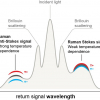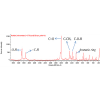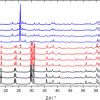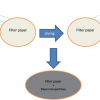Csilla Müller, Leontin David and Simona Cintu Pînzaru*
Babes- Bolyai University, Biomedical Physics, Theoretical and Molecular Spectroscopy Department, Kogalniceanu 1, RO-400084, Cluj-Napoca, Romania. E-mail: [email protected]
Introduction
Thiabendazole (TBZ), [2-(4-thiazolyl) benzimidazole, also known as E233], is a chemical fungicide and parasiticide largely used on vegetables and fruit in order to prevent mould, blight and other diseases resulting from long transportation and storage (Figure 1). TBZ is largely used as an ingredient in waxes applied to the skins of citrus fruits, being generally considered to have low acute dermal toxicity. It is neither irritating to the eyes or skin nor is it a dermal sensitiser. Among toxicity categories, which range from 1 (most toxic) to 4 (least toxic), TBZ is designated as 4. Despite this low acute toxicity, the US Environmental Protection Agency (EPA) has classified TBZ as a slightly toxic pesticide while other sources have classified it as likely to be carcinogenic.1 Currently, EU regulations indicate maximum permitted levels for certain pesticides2 in products of plant origin; consequently, adequate and sensitive techniques are required to control them. Ideally, these methods would work in a non-destructive manner and operate fast at low cost. With regard to TBZ, the Romanian Directive, aligned to the EU regulation, specifies the maximum level as 6 mg kg–1 in the case of citrus fruits. TBZ is not approved as a food additive in the EU.3

Generally, food control is achieved using expensive and time-consuming high-performance liquid chromatography (HPLC) or gas chromatography-mass spectrometry (GC-MS) techniques, while optically-based techniques are undertaken only as laboratory studies of, for example, simple mixtures for which it seems possible that near infrared (NIR) spectroscopy has the potential to detect food adulteration, as recently pointed out by Downey referring to horsemeat.4 Almost 40 years since its discovery, surface-enhanced Raman spectroscopy (SERS), one of the most rapidly-growing techniques, has gained an increased interest from various analytical fields. SERS combines fingerprint specificity with a signal enhancement which is several orders of magnitude greater than conventional Raman spectroscopy and has, for example, been used to investigate the vibrational properties of adsorbed molecules on noble metal nanosurfaces. This has yielded rich information on the adsorbate at very low concentrations.5 SERS uniquely identifies molecules and enables the detection of individual species and their functional groups involved in adsorption processes. The enhancement factor can be as high as 1014–1015, which allows the technique to be sensitive enough to detect single molecules under certain conditions. SERS has provided a capability for detecting traces of organic compounds, contaminants, pesticides and many chemicals, as reflected by the number of publications in the field.5 Combining a NIR excitation laser line with the SERS technique results in the so-called NIR-SERS method. This is particularly challenging, since the most popular noble metal nanoparticles employed in SERS require a visible laser line to achieve the surface plasmon resonance (SPR).In this paper, we demonstrate the possibility of detecting and monitoring the TBZ from organic (known as “bio” in Romania) lemons available on the Romanian market using NIR-SERS and to probe the reproducibility of the technique using a compact, portable, mini-Raman spectrometer.
Experimental
A silver colloid was used as a SERS-active surface. Due to the low TBZ solubility in water (50 mg L–1 at pH 7), ethanol solutions, in which solubility is greater (0.21 g 100 g–1), were prepared. SERS samples were prepared by adding 10 µL from different TBZ stock solutions in the 10–2 mol L–1 to 10–9 mol L–1 range to 500 µL colloidal Ag and immediately measured. We randomly selected the “bio” lemon sample and prepared it by immersing a small piece of its peel into distilled water. After immersion for 15 min, 30 min, 1 h or 24 h, 10 µL of the solution was added to 500 µL colloidal Ag and used for SERS measurements. Fourier transform (FT)-Raman and NIR-SERS spectra of TBZ were recorded with an Equinox 55 Bruker spectrometer incorporating an integrated FRA 106S Raman module. Spectral resolution was 2 cm–1, excitation laser line 1064 nm and the laser power 350 mW. Scans (n = 500) were co-added. SERS spectra of TBZ solutions were also recorded using an Advantage 532 mini-spectrometer (DeltaNu, USA) with a 532 nm excitation line provided by a Nd:YAG laser at an output power of 40 mW and spectral resolution of 10 cm–1. The spectra were recorded over the 200–3400 cm–1 wavenumber range, although the sensitivity of the portable equipment is poor above 2000 cm–1 and below 400 cm–1.
Results and discussions
The optical extinction spectrum of silver colloidal nanoparticles exhibited a band centred at 444 nm. The absorbance evolution of the nanoparticles after adding TBZ is presented in Figure 2, in which a red shift from 444 nm for the freshly-prepared material (a) to 474 nm was observed, after progressively adding small amounts of 10–3 mol L–1 TBZ solution, from 100 µL (b) to 500 µL (e), respectively, indicating increasing aggregation of the nanoparticles in the presence of TBZ. The 30 nm shift and broadening of the absorbance curve suggests a strong aggregation of the nanoparticles in the presence of TBZ. The surface plasmon resonance (SPR) shifted toward longer wavelengths, suggesting the possibility of using NIR excitation laser lines to achieve SERS. The dark-yellow pure colloidal nanoparticles turned to dark green and, depending on the TBZ concentration, rapidly exhibited large aggregates that turned into micro-sediments on the bottom of the vial. For concentrations ranging from nanomole to picomole, the Ag–TBZ complex was stable, even after 24 hours. Although not a selective technique, SPR has been shown to be a potential tool in TBZ detection, although it cannot identify species in a complex mixture.

NIR-SERS signal of TBZ
Due to the strong SPR broadening in the presence of TBZ (Figure 2), we employed the 1064 nm laser line to probe NIR-SERS of the same sample as in the conventional SPR method. As shown by the red arrow in Figure 2, this laser line falls well away from the absorbance bandwidth of the colloidal nanoparticles. A NIR-SERS spectrum of TBZ excited with the 1064 nm laser line is shown in Figure 3 in comparison with the FT-Raman spectrum of solid TBZ powder and conventional SERS signal of 66 nM TBZ, obtained in SPR conditions (532 nm laser line). The most significant NIR-SERS bands are observed at 1574 cm–1, 1545 cm–1, 1285 cm–1, 1225 cm–1, 1032 cm–1, 1006 cm–1 and 784 cm–1 with a very strong band at 236 cm–1 which is absent from (or very weak in) the pure compound spectrum. Small changes in band positions and relative intensity on comparing FT-Raman to NIR-SERS spectra suggest a chemisorption process. According to the SERS selection rules,5,6 vibrational modes with the polarisability component perpendicular to the surface are enhanced. Theoretically, the TBZ species could adsorb through lone pair electrons from a N or S atom (or both), resulting in a perpendicular orientation to the Ag nanoparticles surface, or through the p ring electrons resulting in a planar coverage of the surface. The broadening of those bands which were strongly shifted when compared to the normal Raman features, suggests a tilted-to-parallel orientation of the molecular skeleton with respect to the Ag surface, where the p orbitals of the ring are likely to interact with the metal surface. Due to the much higher sensitivity of the FT-Raman equipment, the low wavenumber range revealed a strong NIR-SERS band at 236 cm–1, also visible in the anti-Stokes range (not shown here) and assigned6 to the Ag–N bond of the chemisorbed TBZ through the N atom. In the conventional SERS signal recorded with the low resolution equipment, with lower sensitivity for both the high and low spectral range (above 2000 cm–1 and below 400 cm–1), the band at 236 cm–1 is weak, although observable to confirm the N-adsorption process. The NIR-SERS band at 1574 cm–1 (assigned to a complex skeletal ring stretching mode of TBZ) and the band at 1006 cm–1 (assigned to the phenyl ring breathing mode) are also enhanced, supporting the suggested perpendicular orientation of the TBZ skeletal plane with respect to the Ag surface. In addition, the strong background observed under visible laser excitation was completely quenched using the NIR excitation line. The distinct band at 784 cm–1 (Figure 3) strongly suggests the S atom is involved in adsorption in the case of TBZ ethanol solution.

In conclusion, this NIR-SERS experiment confirmed the chemisorption of TBZ dissolved in ethanol through both the N and S atoms, resulting in a perpendicular orientation of the TBZ skeletal plane with respect to the Ag nanoparticles surface. Although an impressive SERS detection limit was achieved under SPR conditions (up to 0.66 nM) for the TBZ–ethanol solutions, aqueous extracts would be desirable for monitoring purposes. A totally different SERS behaviour of the TBZ–aqueous solution was found (not shown here) suggesting a different chemisorption process, probably with the skeletal plane tilted to the Ag surface.
SERS signal of aqueous solutions resulting from organic fruit immersion in water
A standard curve relating concentration of TBZ to SERS signal was developed in order to test the ability of the technique to detect TBZ on treated fruits. SERS spectra of TBZ dissolved in water at concentrations ranging from 1.96 × 10–5 mol L–1 to 10–11 mol L–1 are shown in Figure 4 for the whole spectral range achieved using the portable spectrometer. The SERS spectral shape suggests that decreasing concentration does not affect the orientation of the adsorbed species with respect to the Ag surface. The spectral shape of TBZ at 1.96 × 10–11 mol L–1 concentration is still consistent with the main SERS fingerprint of the TBZ aqueous solution and is suggested as the SERS detection limit of TBZ. The SERS signal of TBZ at pH 7 that was successfully identified in the water sample resulted after immersion of a “bio” lemon purchased from a specialised “bio” shop (Figure 4, upper spectrum). Prior to immersion, the fruit was washed with tap water. After 15 min of fruit immersion, TBZ was detectable in the water. Just a small amount (10 µL) of the aqueous solution was enough for the SERS measurement. Longer immersion times generated solutions with higher SERS signal intensities. Taking into account the SERS concentration dependence (Figure 4), the typical SERS signal of neutral TBZ at 10–5 mol L–1 was identified in the sample after 24 h immersion. This result is supported by an additional study of the linear range in the calibration curve of the SERS normalised intensity as a function of concentration together with the relative intensity ratio r of the observed characteristic bands I1389/I484. The value r > 1 is specific only for 10–5 mol L–1 concentration, whereas for lower concentrations, this ratio is r < 1. The result clearly showed that domestic washing of fruit under tap water does not completely remove TBZ, since higher concentration signal detection was achieved after longer water immersion.

The spectral shape easily allowed identification of the TBZ SERS fingerprint although some other small signal contributions from the sample in the 1545–1640 cm–1 range were observed together with a higher Raman background resulting from other possible “impurities” present on the fruits. However, TBZ has been unambiguously detected. Taking into account the TBZ molecular weight of 201.25 g mol–1, and the amount of 10 µL used as SERS sample volume, we could easily estimate for the concentration of 1.96 × 10–5 mol L–1, the total amount of TBZ extracted in 100 mL water as 0.39 mg. This amount obviously exceeds the maximum level of 6 mg kg–1 specified by the current regulations in the case of citrus fruits (orange, pomelo, grapefruit, lemon, mandarin) since the total amount of fruit used in experiment was one small piece of peel (~ 5 g) which provided approximately 78 mg kg–1.
Conclusions
We have demonstrated the possibility of recording NIR-SERS signals from TBZ using conventional Ag nanoparticles based on the broadening of the SPR of the Ag–TBZ complex towards the NIR range. Different SERS behaviour was found for TBZ dissolved in ethanol compared to aqueous solution, for which the detection limit was three orders of magnitude lower for the latter.
NIR-SERS vibrational data were employed to detect TBZ from a treated “bio” lemon sample using the simple approach of immersing them in water and performing SERS with Ag colloidal nanoparticles. The SERS signal of TBZ revealed a specific band intensity ratio (I1389/I484)as a function of concentration which allowed rapid detection of the TBZ concentration level in fruit.
A total amount of 0.39 mg TBZ was estimated in the water sample after 24 h immersion of 5 g citrus peel, which resulted in an estimated dose of 78 mg kg–1, 13 times higher than the maximum allowed by current regulations.
Acknowledgement
Cs. Mueller gratefully acknowledges the financial support from the POSDRU/107/1.5/S/76841.
References
- EPA–738-F-02-002, Prevention, Pesticides and Toxic Substances, May 2002; (www.epa.gov/oppsrrd1/REDs/thiabendazole_red.pdf)
- European Parliament and Council Directive 87/107/EEC on the approximation of the laws of the Member States concerning food additives authorized for use in foodstuffs intended for human consumption, Official. J. Eur. Communities: Legis. 11.02.1989; L40: 27 (1988).
- UK Food Standards Agency, “Current EU approved additives and their E Numbers”, 10–27 (2011). (www.food.gov.uk/policy-advice/additivesbranch/enumberlist#.UPl-WR2TxM4).
- G. Downey, “Can NIR play a role in detecting horsemeat adulteration of minced beef?”, www.impublications.com/content/can-nir-play-role-detecting-horsemeat-adulteration-minced-beef
- S. Schlücker (Ed.), Surface Enhanced Raman Spectroscopy: Analytical, Biophysical and Life Science Applications. Wiley-VCH, Weinheim, Germany (2010).
- N. Peica, I. Pavel, S. Cinta Pinzaru, V.K. Rastogi and W. Kiefer, “Vibrational characterization of E 102 food additive by Raman and surface-enhanced Raman spectroscopy and theoretical studies”, J. Raman Spectrosc. 36, 657 (2005). doi: 10.1002/jrs.1354


















